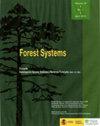阿尔及利亚北部Takoucht山(Béjaïa)阿特拉斯雪松林3 - 6月降水的年轮重建
IF 0.7
4区 农林科学
Q3 FORESTRY
引用次数: 0
摘要
研究目的:利用阿特拉斯雪松(Cedrus atlantica Manetti)的年轮记录,重建了1830-2015年3月至6月的降水量。研究区域:塔库奇特山阿特拉斯雪松林(阿尔及利亚北部贝亚)。材料和方法:计算季节相关性,以确定一年中气候重建的最佳时期。使用分离样本校准验证程序检查降水的树形环信号的时间稳定性。重建采用传递函数法。主要结果:重建数据显示,冬末夏初降水存在较高的年际-年代际变化。19世纪30年代和19世纪40年代,潮湿条件占主导地位,19世纪中期,持续干旱,在重建期间发生了两次最严重的干旱(1858年和1869年)。相对温和的气候条件标志着19世纪末和20世纪初。从20世纪20年代开始,人们观察到干旱条件逐渐恢复,并在20世纪中期达到了高频率干旱。在经历了24年(1966-1989年)异常漫长的潮湿期后,重建工作出现了极端干旱/潮湿事件的最高频率:1993-2002年是重建工作中干旱频率最高的十年,第三严重的干旱事件(1999年),而最近几年则明显转向潮湿条件。研究重点:这些发现提供了阿尔及利亚降雨量最大地区之一过去气候变化的相关记录,并为该地区的具体干旱和潮湿期监测提供了宝贵的知识。本文章由计算机程序翻译,如有差异,请以英文原文为准。
Tree-ring reconstruction of March-June precipitation from the Atlas cedar forest of Mount Takoucht, Béjaïa (northern Algeria)
Aim of study: A March-June precipitation has been reconstructed for the period 1830-2015 using Atlas cedar ( Cedrus atlantica Manetti) tree-ring records. Area of study: Atlas cedar forest of Mount Takoucht (Béjaïa, northern Algeria). Materials and methods: Seasonal correlations were computed in order to identify the best period of the year for the climate reconstruction. The temporal stability of the tree-ring signal for precipitation was checked using the split-sample calibration-verification procedure. The reconstruction was performed using the transfer function method. Main results: The reconstructed data revealed high interannual to decadal variation in late winter to early summer precipitation. Wet conditions dominated during the 1830s and 1840s and were followed by sustained dry conditions during the mid-19 th century, which registered two of the most severe droughts (1858 and 1869) over the period of reconstruction. Relatively moderate climate conditions marked the late 19 th and early 20 th centuries. A gradual return towards drier conditions was observed from the 1920s and reached high frequencies of drought around mid-20 th century. After an exceptional prolonged wet period of 24 years (1966-1989), the reconstruction registered its highest frequency in extreme dry/wet events: the decade 1993-2002 recorded the highest drought frequency of the reconstruction, with the third most severe dry event (1999), while the last years were marked by a clear shift toward wet conditions. Research highlights: These findings provide relevant records on past climate variability in one of the rainiest areas in Algeria and cons titute valuable knowledge for specific drought and wet periods monitoring in the region.
求助全文
通过发布文献求助,成功后即可免费获取论文全文。
去求助
来源期刊

Forest Systems
FORESTRY-
CiteScore
1.40
自引率
14.30%
发文量
30
审稿时长
6-12 weeks
期刊介绍:
Forest Systems is an international peer-reviewed journal. The main aim of Forest Systems is to integrate multidisciplinary research with forest management in complex systems with different social and ecological background
 求助内容:
求助内容: 应助结果提醒方式:
应助结果提醒方式:


